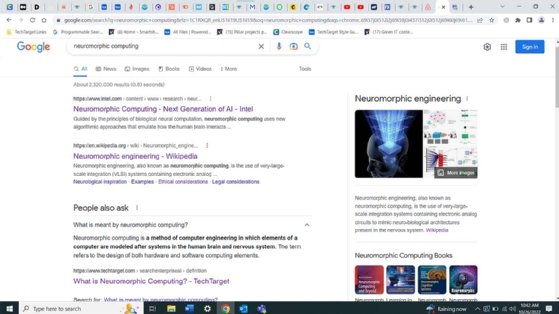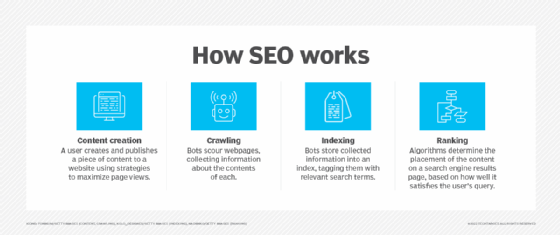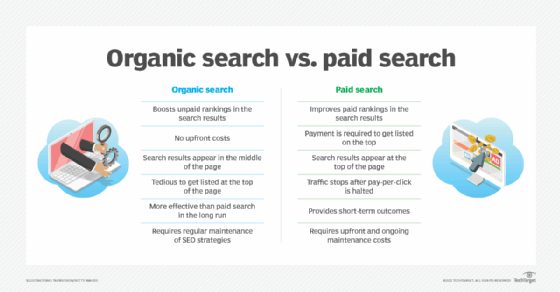search engine results page (SERP)
What are SERPs?
A search engine results page (SERP) is the list of results that a search engine returns in response to a specific word or keyword phrase query. The highest-ranking search results are either the most relevant results or ones that an organization or individual pays the search engine to place at the top of the results page. Search engine algorithms are used to rank content on the page so links become less relevant as the reader moves down the page.
Google, Microsoft Bing and Yahoo are among the most widely used search engines. They include the same common features in their SERPs, such as the following:
- a list of linked webpage titles or title tags;
- URLs to each page listed;
- a brief description of each webpage called the meta description;
- images related to the search;
- a list of People Also Ask (PAA) questions, which includes questions users ask related to a search term and quotes from search results pages answering those questions; and
- advertisements.
Despite having common features, each SERP is unique to the individual who searches. Search engines often customize SERPs based on data such as the user's location and search and browser histories.
Search engine providers are constantly changing their search algorithms to improve the types of results they provide, incorporate new technologies and analyze new webpages. Search engines also offer tools such as Google Analytics, which provides data and analytics capabilities. These tools let content providers and digital marketers track webpage performance, collect data on user traffic and identify trends to improve their ranking on a results page.
How do SERPs work?
There are three main types of webpages on an SERP:
- pages the search engine spider has crawled and indexed;
- pages that have been manually added to the search engine's directory; and
- pages that appear as a result of paid inclusion.
Search engines use complex algorithms and ranking signals, or characteristics that lead to favorable rankings, to analyze these indexed webpages and multimedia content in real time when a user makes a search. They then position the webpages and links to them from most to least relevant on the results page. SERPs also consider data such as the searcher's location and search and browser histories when presenting results.
Search engine providers are not transparent about how their algorithms work, what their ranking signals are and how many they use. However, there are some known factors, such as the following:
- Number of backlinks. The number of external webpages linking to one specific page is significant in determining SERP ranking. A lot of backlinks to a webpage indicates the page is an authority on a subject and trustworthy.
- Number of relevant keywords. The use of a comprehensive set of keywords relevant to a topic has a positive effect on ranking. However, this should not be confused with keyword stuffing, which search engines do not like. Google shares information on how keywords and phrases have been searched over time with its Google Trends tool.
- Organization. Google's algorithm is the one we know most about, and it favors pages organized into simple sections that make it easy for a user to navigate and skim. The algorithm also favors content written in simple terms.
- User experience. UX details such as webpage loading speeds, security and ease of use are factored into content rankings on SERPs.
- Trust signals. Search engines also consider cumulative data such as a website's security, credibility, traffic and backlinks over time.

Common SERP features
Based on ranking signals or the characteristics a search engine deems important, search engines create a results page. These SERPs include the following features:
- Featured snippets. Featured snippets are pieces of content displayed at the top of the SERP. If a search query is made in the form of a question, featured snippets will choose content from a webpage that answers that question and display it above the organic results.
- Knowledge graph. The knowledge graph, also known as the knowledge panel, is a box that appears at the right side of the SERP. This graph is most used for informational queries, such as queries about individuals or organizations. It includes relevant information about the query, including important dates, facts and images.
- Local pack. A local pack appears when an individual searches for a specific local business or a type of business. For instance, if a user searches for restaurants in their area, a local pack will appear. It contains a map with locations the search engine thinks are helpful, plus customer ratings, business phone numbers and other information.
- Rich snippets. Rich snippets are like local packs in that they give information about businesses. Rich snippets appear in the typical webpage listing directly below the page title and include information such as a business's average customer star rating and how expensive it is using a range of dollar signs from one to four.
- Image results. Image results, or image packs, are one of the oldest and most shared SERP features. For instance, Google images are often provided at the top of Google search results. Users can also search an image or do what's called a reverse image search by dragging and dropping an image file onto the search box.
- Video results. Video results are another long established, common SERP feature. Depending on their relevancy to the search term, video results often appear at the top of SERP above organic results but below images and featured snippets. For instance, if a user searches for a musician or band, a music video will often appear below an image result and a featured organic result like Wikipedia.
- People Also Ask. PAAs are a series of questions related to searcher's query posted at the top of a SERP. When a user clicks on one of the questions, an answer pops up from a high ranking webpage. To be included as an answer to a PAA, a webpage usually must be on the first page of the SERP, though that isn't always the case.
- Twitter results. SERPs sometimes include relevant Twitter posts, especially for events with a lot of live coverage. For instance, if a user searches for a sporting event, tweets that provide live updates and instant reactions will appear at the top of the SERP.
- Top stories. Top stories appear at the top of the SERP for certain results. These are usually news stories related to a query.
- Shopping. Many users search for products. Many search engines such as Google have a shopping feature that presents both organic and paid shopping results for products, as well as product reviews and related webpages.
What is search engine optimization (SEO)?
In most cases, search engine users will look at only the first one to three pages of results. Web designers, site owners and content managers use SEO methods to make their sites and pages appear at or near the top of a SERP.
The goal of SEO is to use the limited knowledge available about search engine algorithms and ranking factors to optimize information on a page, so it organically ranks as high as possible on the first page of SERPs. The thinking is that the higher on the SERP a piece of content, webpage or website is, the more traffic it will get. Websites make money when users click on their pages, so driving as much traffic as possible to them is the goal.
Most SEO practices focus on Google, which is the most popular search engine. Because Google is so secretive about its ranking methods, much of SEO is guesswork and involves experimenting with different approaches. Search engine algorithms are also frequently changing, meaning strong SEO practices must change with them.
Important SEO techniques include the following:
- Technical optimization. This involves using features like an Extensible Markup Language (XML) sitemap, also known as an XML schema definition. This provides Google with information about a site's pages and content.
- On-page optimization. Content managers create informative, user-friendly content. They include a comprehensive relevant keyword in the headings and body of a webpage, informative meta descriptions, an optimized UX, and links to other pages on the host site or external sites. Organizations sometimes use content management systems to maintain on-page content.
- Off-page optimization generally involves generating backlinks and other forms of traffic to a webpage or website to boost trust signals and authoritativeness. Webpages create backlinks through social media campaigns, partnerships or being a trusted, frequently visited authority on a topic.

Organic vs. paid search results
Organic search results and paid search results are the two result types on a SERP. The format of both results are similar, and both are important to capturing customer traffic particularly at the beginning of a customer journey.
Organic search results
Organic results are ones a search engine's algorithm and ranking signals favor. Organic results are ranked based on how well they address a search engine's algorithms through SEO.
There is no way to pay a search engine to organically rank a page higher than others. Digital marketing techniques are used to improve organic search results. Besides boosting traffic and showing search engines that a page is authoritative and trustworthy, the benefits of organic listings are that they don't cost money unlike paid results, and they offer a strong return on investment.
Paid search results
Paid search results are also known as sponsored links or Google ads on Google's search page results. They are webpages an individual or organization pays a search engine to put on the first page of a search result. Paid results appear at the top of the page before all other content and include a tag to the left of their sitelink letting users know it is an "Ad."
Paid results are targeted ads where the advertiser or digital marketer purchases specific keywords and keyword phrases from the search engine provider. Search engines like Google often show three to four paid ads at the top of their search results pages. The top ranking paid ad usually goes to the organization or individual who pays the most money. However, Google also considers the quality of the webpage itself, as well as the quality and relevance of the ad. Digital marketers often use the pay-per-click (PPC) model when placing ads. The PPC model means an advertiser pays search engines like Google when their ad is clicked on.
The benefit of paid ads is that they ensure a webpage appears at the top of a search. However, paid results clearly say they are ads; some users are aware that ads are at the top simply because they have paid to be there and are therefore less likely to trust and click on them.

Ranking high on SERPs is the goal of search engine optimization. Learn the top SEO marketing challenges and some ways to address them.
